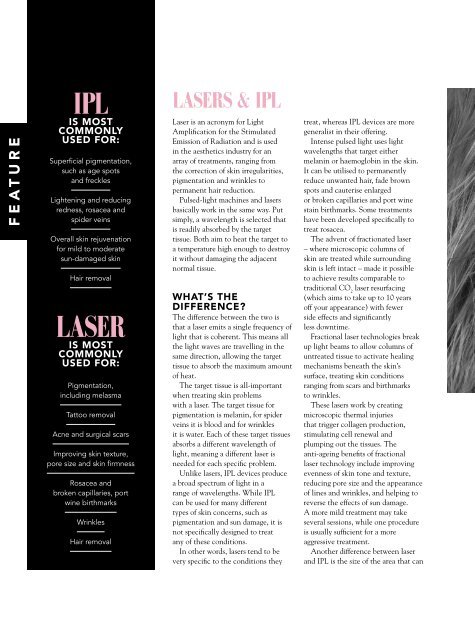CosBeauty Magazine #90
CosBeauty is the #BeautyAddict's guide to lifestyle, health and beauty in Australia and New Zealand. In this issue: - Summer Body; Meet this season's glow getters - 80+ Products to up your skincare game - 2020 Beauty lovers Christmas gift guide - Face-to-Face; the non-surgical tweakments turning heads
CosBeauty is the #BeautyAddict's guide to lifestyle, health and beauty in Australia and New Zealand.
In this issue:
- Summer Body; Meet this season's glow getters
- 80+ Products to up your skincare game
- 2020 Beauty lovers Christmas gift guide
- Face-to-Face; the non-surgical tweakments turning heads
You also want an ePaper? Increase the reach of your titles
YUMPU automatically turns print PDFs into web optimized ePapers that Google loves.
FEATURE<br />
IPL<br />
IS MOST<br />
COMMONLY<br />
USED FOR:<br />
Superficial pigmentation,<br />
such as age spots<br />
and freckles<br />
Lightening and reducing<br />
redness, rosacea and<br />
spider veins<br />
Overall skin rejuvenation<br />
for mild to moderate<br />
sun-damaged skin<br />
Hair removal<br />
LASER<br />
IS MOST<br />
COMMONLY<br />
USED FOR:<br />
Pigmentation,<br />
including melasma<br />
Tattoo removal<br />
Acne and surgical scars<br />
Improving skin texture,<br />
pore size and skin firmness<br />
Rosacea and<br />
broken capillaries, port<br />
wine birthmarks<br />
Wrinkles<br />
Hair removal<br />
LASERS & IPL<br />
Laser is an acronym for Light<br />
Amplification for the Stimulated<br />
Emission of Radiation and is used<br />
in the aesthetics industry for an<br />
array of treatments, ranging from<br />
the correction of skin irregularities,<br />
pigmentation and wrinkles to<br />
permanent hair reduction.<br />
Pulsed-light machines and lasers<br />
basically work in the same way. Put<br />
simply, a wavelength is selected that<br />
is readily absorbed by the target<br />
tissue. Both aim to heat the target to<br />
a temperature high enough to destroy<br />
it without damaging the adjacent<br />
normal tissue.<br />
WHAT’S THE<br />
DIFFERENCE?<br />
The difference between the two is<br />
that a laser emits a single frequency of<br />
light that is coherent. This means all<br />
the light waves are travelling in the<br />
same direction, allowing the target<br />
tissue to absorb the maximum amount<br />
of heat.<br />
The target tissue is all-important<br />
when treating skin problems<br />
with a laser. The target tissue for<br />
pigmentation is melanin, for spider<br />
veins it is blood and for wrinkles<br />
it is water. Each of these target tissues<br />
absorbs a different wavelength of<br />
light, meaning a different laser is<br />
needed for each specific problem.<br />
Unlike lasers, IPL devices produce<br />
a broad spectrum of light in a<br />
range of wavelengths. While IPL<br />
can be used for many different<br />
types of skin concerns, such as<br />
pigmentation and sun damage, it is<br />
not specifically designed to treat<br />
any of these conditions.<br />
In other words, lasers tend to be<br />
very specific to the conditions they<br />
treat, whereas IPL devices are more<br />
generalist in their offering.<br />
Intense pulsed light uses light<br />
wavelengths that target either<br />
melanin or haemoglobin in the skin.<br />
It can be utilised to permanently<br />
reduce unwanted hair, fade brown<br />
spots and cauterise enlarged<br />
or broken capillaries and port wine<br />
stain birthmarks. Some treatments<br />
have been developed specifically to<br />
treat rosacea.<br />
The advent of fractionated laser<br />
– where microscopic columns of<br />
skin are treated while surrounding<br />
skin is left intact – made it possible<br />
to achieve results comparable to<br />
traditional CO 2<br />
laser resurfacing<br />
(which aims to take up to 10 years<br />
off your appearance) with fewer<br />
side effects and significantly<br />
less downtime.<br />
Fractional laser technologies break<br />
up light beams to allow columns of<br />
untreated tissue to activate healing<br />
mechanisms beneath the skin’s<br />
surface, treating skin conditions<br />
ranging from scars and birthmarks<br />
to wrinkles.<br />
These lasers work by creating<br />
microscopic thermal injuries<br />
that trigger collagen production,<br />
stimulating cell renewal and<br />
plumping out the tissues. The<br />
anti-ageing benefits of fractional<br />
laser technology include improving<br />
evenness of skin tone and texture,<br />
reducing pore size and the appearance<br />
of lines and wrinkles, and helping to<br />
reverse the effects of sun damage.<br />
A more mild treatment may take<br />
several sessions, while one procedure<br />
is usually sufficient for a more<br />
aggressive treatment.<br />
Another difference between laser<br />
and IPL is the size of the area that can

















